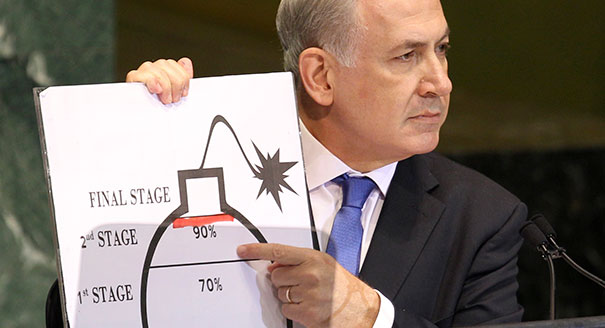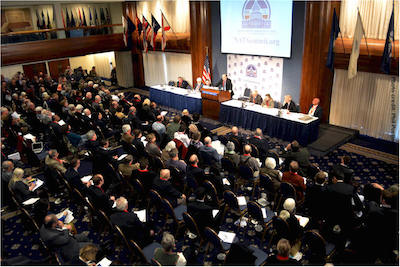A Poison Pill for the Iran-Nuke Deal
Oct 1 2014 / 6:15 pm
By Paul R. Pillar.
ConsortiumNews – Many in Congress continue to march in lockstep with the dictates of Israeli Prime Minister Netanyahu who wants endless hostility toward Iran even if that torpedoes a deal to constrain Iran’s nuclear program. That includes a pointless demand for a past confession, notes ex-CIA analyst Paul R. Pillar.
Some of the most recent efforts to derail a nuclear agreement with Iran have been focusing on what has come to be called “possible military dimensions” (PMD), a term that refers to any work Iran has performed in the past on designing nuclear weapons.
One of the latest such efforts is a letter that the leaders of the House Foreign Affairs Committee, Edward Royce and Eliot Engel, have circulated for signature by their congressional colleagues. The letter essentially says that all questions about PMD need to be cleared up before we can reach any agreement to restrict Iran’s nuclear program.
The government of Iran will not issue during the next couple of months a public confession about past research or design work on nuclear weapons. This simply won’t happen. So for the United States or its negotiating partners to make clearing up of all questions about PMD a prerequisite to signing an agreement would be a deal-killer. Most of those pushing the PMD issue hardest probably recognize it would be a deal-killer, which is why they are pushing it.
The Royce-Engel letter attempts to relate past behavior to future requirements in enforcing an agreement by asserting there must be a “baseline” of information about the past to assess Iran’s current and future nuclear activity. That assertion lacks logic. Baseline information is important in many things, where what matters is the amount and direction of change in a continuing process — such as what is measured by achievement test scores in education, or by blood tests tracking the level of an antigen produced by the human body.
But under an agreement with Iran no work on nuclear weapons would be allowed. It’s not a matter of comparing the pace of current activity with the pace of past activity. Any such activity would be a clear violation of Iran’s obligations under the agreement, as well as its existing obligations under the Nuclear Nonproliferation Treaty.
The single biggest reason, from the standpoint of preventing an Iranian nuclear weapon, for completing the agreement under negotiation is to extend and expand the inspection arrangements — already, under the preliminary agreement, unprecedented in their scope and intensity — including full adherence to the Additional Protocol governing inspections by the International Atomic Energy Agency.
That is what is needed to be confident that the Iranian nuclear program remains peaceful — not some ‘fessing up about something done in the distant past. Besides, if the Iranians really wanted to cheat, they would be stupid simply to pick up or duplicate what they had done in the past (and which they already knew Western governments and intelligence services were on to).
The distant past is getting steadily more distant, and even more irrelevant to present concerns. Thepublicly expressed judgment of the U.S. intelligence community on this subject is that Iran did work on the design of nuclear weapons but that it ceased such work in 2003, now more than a decade ago.
The basic choice in handling the PMD issue in the negotiations now in progress is between attempting to get a confession about behavior that ended more than a decade ago and getting an agreement that provides the best possible assurance that there will be no Iranian nuclear weapon in the future. The advantage of choosing the latter option should be obvious enough when the choice is phrased that way.
It should be even more obvious when considering that in terms of actual results, the realistic alternatives are, on one hand, being hard-line on the PMD issue and getting neither the confession nor an agreement, and on the other hand, getting an agreement that restricts and monitors Iran’s nuclear program to an extent that years of pressure and hard-lining on our side never were able to achieve.
In the history of nuclear nonproliferation efforts, the failures — including one conspicuous case of not acknowledging either past or current activity — have been offset by successes that have included several cases, ranging from Sweden to South Korea, in which states with nuclear weapons programs moved away from them and decided instead to commit themselves to a nuclear-weapons-free future. Isn’t that what we supposedly want from Iran today?
Those earlier cases did not involve past confessions but instead a straightforward commitment to keeping national nuclear programs peaceful in the present and future. In a speech on the floor of the Senate in January, Sen. Dianne Feinstein, D-California, referred to such earlier cases in stating, “I believe countries can change. This capacity to change also applies to the pursuit of nuclear weapons.”
The question before us, said the senator, is whether Iran is “willing to change its past behavior.” It is change from past behavior, not a public confession about past behavior, that matters.
It is the “job of diplomacy,” said Feinstein, “to push for that change.” It is the job of analysts and pundits to realize that agreements need to be assessed according to how they shape future behavior, not just make some statement about the past.
Paul R. Pillar, in his 28 years at the Central Intelligence Agency, rose to be one of the agency’s top analysts. He is now a visiting professor at Georgetown University for security studies. (This article first appeared as a blog post at The National Interest’s Web site. Reprinted with author’s permission.)

